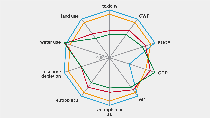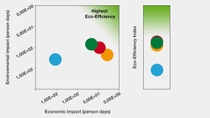Sustainability
Eco-Efficiency Analysis
The purpose of Eco-Efficiency Analysis is to harmonize economy and ecology. This involves carrying out an overall study of alternative solutions to include a total cost determination and the calculation of ecological impact over the entire life cycle.
Eco-Efficiency Analysis looks at environmental impact in proportion to a product's cost-effectiveness. It helps BASF, BASF’s customers, and customers’ customers to decide which products are the best choice, both ecologically and economically. The Eco-Efficiency Analysis can also be used to identify ways to make improvements in terms of environmental impact and cost.
BASF established this holistic method in 1996 and was one of the first companies in the chemical industry to do so. The Eco-Efficiency Analysis was most recently validated by NSF International in 2016. The Eco-Efficiency Analysis follows ISO 14040:2006 and 14044:2006 for environmental life cycle assessments. The assessment of life cycle costs and aggregation to an overall Eco-Efficiency is based on ISO 14045:2012.
For example, Eco-Efficiency Analysis can be applied to support customers´ sustainable development along the value chain by reducing energy and resources.
A holistic Life Cycle Approach
The Eco-Efficiency Analysis compares the life cycles of products or manufacturing processes in a holistic approach from the assessment including raw materials sourcing, product manufacture and use, to disposal or recycling. For example, it includes the environmental impact of products used by BASF as well as of starting materials manufactured by others. The analysis also takes the consumption behavior of end-users into account, as well as various recycling and disposal options. In a recent eco-efficiency analysis, BASF and the supplier of converting solutions for the flexible packaging industry Comexi wanted to find out which laminating adhesive technologies are the most eco-efficient. Therefore, solvent-based polyurethane (SB), solventless polyurethane (SL), water-based polyurethane (WB-PU) and water-based acrylic (WB-A) laminating adhesives were analyzed and compared according to the above mentioned Eco-Efficiency methodology. How much energy is needed to fulfill the customer benefit? What emissions and waste result? And how good are the packaging parameters and costs? Questions like these helps to determine which product best meets customer needs and which offers the most eco-efficient solution.

How does an Eco-Efficiency Analysis work?
First, the environmental impact is assessed based on a range of categories:
- Raw materials consumption (Resource depletion)
- Water consumption (Water use)
- Land use (Land use)
- Human toxicity potential (Toxicity)
- Eutrophication (Eutrophic. fr, Eutrophic. mar),
- Acidification (AP)
- Ozone depletion (ODP)
- Photochemical ozone creation (POCP)
- Climate change (GWP)
Combining these individual data gives the total environmental impact of a product or process. Economic data are also compiled. All the various costs incurred in manufacturing or using a product are included in the calculation. The economic analysis and the overall environmental impact are used to make Eco-Efficiency comparisons.
Economic and ecological data are plotted on the Eco-Efficiency Portfolio. The costs are shown on the horizontal axis and the environmental impact is shown on the vertical axis. The graph reveals the Eco-Efficiency of a product or process compared to other products or processes. And it allows us to look into the future, since Eco-Efficiency Analysis is utilized in making strategic decisions and it also helps detect and exploit potential ecological and economic improvements.

BASF’s Eco-Efficiency Analysis is based on DIN EN ISO 14040 and 14044 for ecological evaluations. For economic evaluations and the resulting aggregated Eco-Efficiency Analysis ISO 14045 is the foundation since 2012.
BASF's method for Eco-Efficiency Analysis is validated in 2019 by NSF (USA) for the last time.
BASF Eco-Efficiency Analysis helps to identify sustainability drivers of products
20 years of Eco-Efficiency Analysis
The anniversary book “The BASF Eco-Efficiency Analysis – A 20-year success story” reports on the beginnings of the method and its further development over two decades in addition to presenting numerous example studies. You can order the book here.
